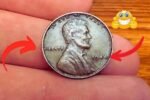This Penny Was His Good Luck Charm: Every teenager has their superstitions—a lucky shirt for game day, a special pencil for tests. For Matthew Keller, it was a simple penny he found on the first day of high school. What began as a personal good-luck charm would one day become a national treasure, displayed proudly at the Smithsonian Institution.
A Teenager’s Simple Ritual
It was 2005 in a small Ohio town when freshman Matthew Keller spotted the penny in the school parking lot. At first, it was just spare change. But after an unexpected good grade on a test, the coin became something more—a tiny talisman against teenage anxieties.
“It probably didn’t actually change anything,” Matthew later admitted with a smile. “But when you’re 14, you’ll believe anything that gives you a little confidence.” The penny traveled with him everywhere: in his pocket during exams, tucked in his wallet for first dates, even secretly held during his valedictorian speech. Friends chuckled, but Matthew didn’t mind. To him, it was more than metal—it was a reminder that he could succeed.
The Astonishing Discovery
Years later, as an archaeology student, Matthew brought his worn lucky penny to a coin workshop. What he assumed was an ordinary 1970s Lincoln cent turned out to be one of the rarest U.S. coins in existence—a 1943 bronze penny mistakenly struck during World War II.
Most 1943 pennies were made of steel due to wartime metal rationing. Only about 20 bronze specimens are known to exist, making Matthew’s high school good-luck charm a numismatic miracle. “The odds are beyond astronomical,” marveled a coin historian. “For it to circulate unnoticed for decades, then wind up with someone who cherished it? That’s history playing the long game.”
From Pocket Change to Museum Piece
After authentication, Matthew made a surprising decision: he donated the penny to the Smithsonian’s National Museum of American History. Today, it sits in the “Value of Money” exhibit, displayed alongside Matthew’s story of how a teenager’s superstition intersected with numismatic history.
“This coin represents how ordinary people give meaning to everyday objects,” explained a curator. Visitors now pause at the display, some sharing their own stories of childhood lucky charms—baseball cards, seashells, or other small tokens that once felt magical.
More Than Metal
Now working in museum education, Matthew reflects on the penny’s journey with quiet wisdom. “I thought it gave me luck,” he said at the exhibit opening. “Really, it just helped me find confidence within myself.” The coin’s new role has inspired students nationwide, with teachers using its story to discuss history, psychology, and the personal value we assign to objects.
Since the penny’s installation, the Smithsonian has noticed increased interest in their money exhibits. Social media buzzes with #MyLuckyCharm stories, and coin collectors report more young people asking about pocket change.
A Reminder to Notice Small Wonders
In our fast-paced digital age, Matthew’s penny whispers an important truth: significance often hides in plain sight. That worn coin in your drawer, the smooth stone on your windowsill—they might not be museum-worthy, but they carry stories worth remembering.
As visitors file past the Smithsonian display, many find themselves checking their pockets afterward. Not just for rare coins, but for those small, ordinary objects that once—or still—make them feel like anything is possible.



